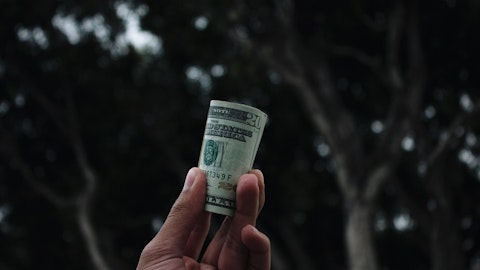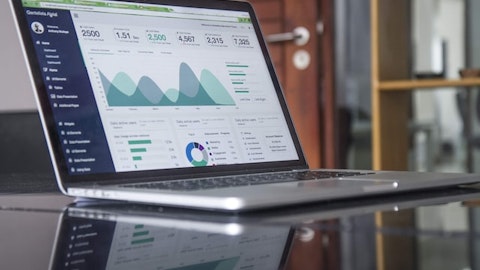Stellus Capital Investment Corporation (NYSE:SCM) Q3 2023 Earnings Call Transcript November 8, 2023
Operator: Good morning, ladies and gentlemen, and thank you for standing by. At this time, I would like to welcome everyone to Stellus Capital Investment Corporation’s Conference Call to Report Financial Results for its Third Fiscal Quarter Ended September 30, 2023. [Operator Instructions] This conference is being recorded today, November 8, 2023. It is now my pleasure to turn the call over to Mr. Robert Ladd, Chief Executive Officer of Stellus Capital Investment Corporation. Mr. Ladd, you may begin your conference.
Robert Ladd: Okay. Thank you, Holly. Good morning, everyone, and thank you for joining the call. Welcome to our conference call covering the quarter ended September 30, 2023. Joining me this morning is Todd Huskinson, our Chief Financial Officer, who will cover important information about forward-looking statements as well as an overview of our financial information.
Todd Huskinson: Thank you, Rob. I’d like to remind everyone that today’s call is being recorded. Please note that this call is the property of Stellus Capital Investment Corporation and that any unauthorized broadcast of this call in any form is strictly prohibited. Audio replay of the call will be available by using the telephone number and pin provided in our press release announcing this call. I’d also like to call your attention to the customary safe harbor disclosure in our press release regarding forward-looking information. Today’s conference call may also include forward-looking statements and projections, and we ask that you refer to our most recent filing with the SEC for important factors that could cause actual results to differ materially from these projections.
We will not update any forward-looking statements unless required by law. To obtain copies of our latest SEC filings, please visit our website at www.stelluscapital.com under the Public Investors link or call us at 713-292-5400. At this time, I’d like to turn the call back over to our Chief Executive Officer, Rob Ladd.
Robert Ladd: Okay. Thank you, Todd. Todd will now cover our operating results, life-to-date review, and portfolio and asset quality.
Todd Huskinson: Thank you, Rob. In the third quarter, we more than covered the dividend of $0.40 per share with GAAP net investment income of $0.47 per share. Core net investment income was $0.49 per share, which excludes estimated excise taxes and the impact of capital gains incentive fees. Net asset value per share was lower as a result of some unrealized losses in our investment portfolio. These were company specific, and we don’t believe are indicative of overall asset quality. Net investment income exceeded the dividend by $1.5 million, and we also issued additional shares of $21.5 million on a net basis, all at or above net asset value. From a life-per-day perspective, since our IPO in November 2012, we’ve invested approximately $2.4 billion in over 191 companies and received approximately $1.5 billion of repayments, while maintaining stable asset quality.
We have paid over $233 million of dividends to our investors, which represents $14.55 per share to an investor in our IPO in November 2012. We ended the quarter with an investment portfolio at fair value of $886 million across 96 portfolio companies, up from $882 million across 93 companies at June 30, 2023. During the third quarter, we invested $44.1 million in six new and six existing portfolio companies. And along with additional fundings of $4.7 million and received two full repayments totaling $21 million and $15 million of other repayments, resulting in net portfolio growth at cost of $4.7 million. At September 30, 99% of our loans were secured and 97% were priced at floating rates. We are always focused on diversification. The average loan per company is $9.9 million and the largest overall investment is $18.9 million, both at fair value.
Substantially, all the portfolio companies are backed by a private equity firm. Overall, our asset quality is below a rating of 2, therefore, slightly better than planned. 25% of our portfolio is rated a 1 or ahead of plan and 14% of the portfolio is marked at an investment category of 3 or below. Currently, we have five loans on nonaccrual, which comprised 1.6% of the fair value of our total loan portfolio. With that, I’ll turn it back over to Rob to discuss dividends and the overall outlook.
Robert Ladd: Okay. Thank you, Todd. As a reminder, part of our investment strategy has been to invest in the equity of our portfolio companies in a modest way in order to generate realized gains sufficient to offset losses over time. While we’ve had modest equity realization so far this year, we expect this activity to pick up over the next six to 12 months. As of the end of the quarter, we have $57 million of equity investments at costs that were marked at $66 million. Our historical performance would indicate that the ultimate realization of this portfolio could be greater than 2x our portfolio’s cost basis. However, of course, the ultimate performance of our current equity positions will depend on a variety of factors, including, among other things, the current economic environment and sponsors equity exit strategies, rather.
Now turning to dividends. We continue to cover our dividend of $0.40 per share per quarter as a result of the greater earnings that we are generating in this higher interest rate environment. We are well positioned to benefit from the higher interest rates as our portfolio is over 97% floating rate, and our liability structure is approximately 65% fixed rate. As a reminder, as we are now in the fourth quarter, the November dividend is paid on December 15 and the December dividend is paid on December 29. Looking forward to Q1 of 2024, we expect, subject to our Board of Directors’ approval, to continue our monthly dividend of approximately $0.13 per share, resulting in aggregate dividends of $0.40 per share for the quarter. It’s worth noting that based on the average price of our stock over the last 10 days ending yesterday, our current dividend equates to an annual yield of 12.5%.
Now turning to outlook, since quarter end, we have funded $3.2 million at par and five existing portfolio companies and have received one repayment of $400,000. This brings our total portfolio to approximately $888 million at fair value with 95 portfolio companies. We are experiencing a somewhat slower environment for originations than in the previous few quarters. And we expect our funding for the remainder of the year will be offset by expected repayments of approximately the same amount. As a result, we estimate we’ll end the year flat quarter-over-quarter. Now with that, I’ll open it up for questions. Thank you. And Holly, you can begin the Q&A session, please.
See also Goldman Sachs Solar and Green Energy Stocks: Top 10 Stock Picks and 30 Most Economically Powerful Countries in the World.
Q&A Session
Follow Stellus Capital Investment Corp (NYSE:SCM)
Follow Stellus Capital Investment Corp (NYSE:SCM)
Operator: Certainly. [Operator Instructions] Your first question for today is coming from Christopher Nolan at Ladenburg Thalmann.
Christopher Nolan: Hi, guys. The increase in nonaccrual assets, what is the thinking? Is – given the broader economy, is the inclination to work through these or to try to exit them?
Robert Ladd: So Chris, good question. It has been our mode for now almost 20 years that we work through things and versus sell them off. And so that’s our – that would not change. So continue to work through problems. And ultimately, we found the realizations are better overall that way.
Christopher Nolan: Okay. And then, Rob, what is the thoughts on leverage? You’re already covering the dividend. Is the thought to keep the leverage low, take the excise tax hit and just – or just to increase leverage? And how are you thinking about.
Robert Ladd: Sure. So we have reached a point on leverage based on equity issue under the ATM program and some repayments where we’re less levered than normal. We target the regulatory leverage to be at 1:1 or so. We’re now, I believe, about 0.8 or so to 1. So we would expect the leverage to tick back up to 1:1 and have a more full portfolio, which we think is a good position to be in.
Christopher Nolan: Final question. In your comments, you mentioned the first quarter ’24 dividend of $0.13 per share per month. Did you mean fourth quarter ’23 or…
Robert Ladd: Yes. No. So what I was referring to is we’re now – we declared the dividends for the fourth quarter of this year. So just to indicate that based on the performance of where we’re headed, we would expect that dividend to continue on to into the first quarter of next year, again, subject to Board approval.
Christopher Nolan: Great. Thank you for the clarification. That’s it for me.
Robert Ladd: Yes. Thank you, Chris.
Operator: Your next question for today is coming from Robert Dodd with Raymond James.
Robert Dodd: Hi. Good morning. Just I want to ask you about Arbor Works. Obviously, last quarter, you told us you’re going to put Arbor Works, which you did. And you – it’s a pretty large chunk of the unrealized depreciation this quarter, so I presume working through. But you’ve also then in October made a small couple of hundred thousand dollar follow-up. Can you give us any – is that working capital? Is that part of the work it through process? Or is that the sponsor stepped up and put in equity and you put in a little bit of that as well. Can you give us any color on that since that was — yes, what your biggest moves this quarter?
Robert Ladd: Sure. Yes. So this – again, as you know, we really limit our discussion about private companies for competitive reasons. But I would say this is the normal working through a situation with the sponsor, who’s been supportive and where there’s some modest additional fundings on both sides.
Robert Dodd: Got it. Got it. Thank you. On – just looking to your point on the equity co-invest potential realizations over the next, call it, a year. Can you give us – so what kind of market environment needs to be going on for those realizations to occur? And what would that mean more broadly for the rest of the portfolio, to that point, maybe getting the leverage back up to your target? I think – are those two things just intrinsically related when you couldn’t have the realizations without portfolio growth? Or what are your thoughts there?






